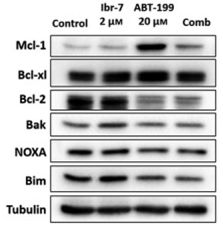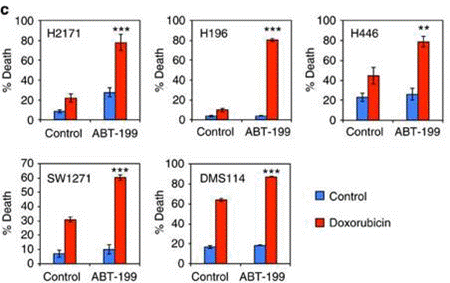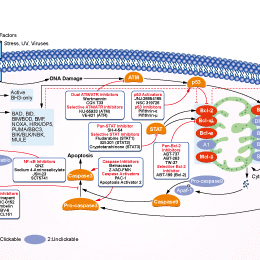
- Bioactive Compounds
- By Signaling Pathways
- PI3K/Akt/mTOR
- Epigenetics
- Methylation
- Immunology & Inflammation
- Protein Tyrosine Kinase
- Angiogenesis
- Apoptosis
- Autophagy
- ER stress & UPR
- JAK/STAT
- MAPK
- Cytoskeletal Signaling
- Cell Cycle
- TGF-beta/Smad
- Compound Libraries
- Popular Compound Libraries
- Customize Library
- Clinical and FDA-approved Related
- Bioactive Compound Libraries
- Inhibitor Related
- Natural Product Related
- Metabolism Related
- Cell Death Related
- By Signaling Pathway
- By Disease
- Anti-infection and Antiviral Related
- Neuronal and Immunology Related
- Fragment and Covalent Related
- FDA-approved Drug Library
- FDA-approved & Passed Phase I Drug Library
- Preclinical/Clinical Compound Library
- Bioactive Compound Library-I
- Bioactive Compound Library-Ⅱ
- Kinase Inhibitor Library
- Express-Pick Library
- Natural Product Library
- Human Endogenous Metabolite Compound Library
- Alkaloid Compound LibraryNew
- Angiogenesis Related compound Library
- Anti-Aging Compound Library
- Anti-alzheimer Disease Compound Library
- Antibiotics compound Library
- Anti-cancer Compound Library
- Anti-cancer Compound Library-Ⅱ
- Anti-cancer Metabolism Compound Library
- Anti-Cardiovascular Disease Compound Library
- Anti-diabetic Compound Library
- Anti-infection Compound Library
- Antioxidant Compound Library
- Anti-parasitic Compound Library
- Antiviral Compound Library
- Apoptosis Compound Library
- Autophagy Compound Library
- Calcium Channel Blocker LibraryNew
- Cambridge Cancer Compound Library
- Carbohydrate Metabolism Compound LibraryNew
- Cell Cycle compound library
- CNS-Penetrant Compound Library
- Covalent Inhibitor Library
- Cytokine Inhibitor LibraryNew
- Cytoskeletal Signaling Pathway Compound Library
- DNA Damage/DNA Repair compound Library
- Drug-like Compound Library
- Endoplasmic Reticulum Stress Compound Library
- Epigenetics Compound Library
- Exosome Secretion Related Compound LibraryNew
- FDA-approved Anticancer Drug LibraryNew
- Ferroptosis Compound Library
- Flavonoid Compound Library
- Fragment Library
- Glutamine Metabolism Compound Library
- Glycolysis Compound Library
- GPCR Compound Library
- Gut Microbial Metabolite Library
- HIF-1 Signaling Pathway Compound Library
- Highly Selective Inhibitor Library
- Histone modification compound library
- HTS Library for Drug Discovery
- Human Hormone Related Compound LibraryNew
- Human Transcription Factor Compound LibraryNew
- Immunology/Inflammation Compound Library
- Inhibitor Library
- Ion Channel Ligand Library
- JAK/STAT compound library
- Lipid Metabolism Compound LibraryNew
- Macrocyclic Compound Library
- MAPK Inhibitor Library
- Medicine Food Homology Compound Library
- Metabolism Compound Library
- Methylation Compound Library
- Mouse Metabolite Compound LibraryNew
- Natural Organic Compound Library
- Neuronal Signaling Compound Library
- NF-κB Signaling Compound Library
- Nucleoside Analogue Library
- Obesity Compound Library
- Oxidative Stress Compound LibraryNew
- Plant Extract Library
- Phenotypic Screening Library
- PI3K/Akt Inhibitor Library
- Protease Inhibitor Library
- Protein-protein Interaction Inhibitor Library
- Pyroptosis Compound Library
- Small Molecule Immuno-Oncology Compound Library
- Mitochondria-Targeted Compound LibraryNew
- Stem Cell Differentiation Compound LibraryNew
- Stem Cell Signaling Compound Library
- Natural Phenol Compound LibraryNew
- Natural Terpenoid Compound LibraryNew
- TGF-beta/Smad compound library
- Traditional Chinese Medicine Library
- Tyrosine Kinase Inhibitor Library
- Ubiquitination Compound Library
-
Cherry Picking
You can personalize your library with chemicals from within Selleck's inventory. Build the right library for your research endeavors by choosing from compounds in all of our available libraries.
Please contact us at info@selleckchem.com to customize your library.
You could select:
- Antibodies
- Bioreagents
- qPCR
- 2x SYBR Green qPCR Master Mix
- 2x SYBR Green qPCR Master Mix(Low ROX)
- 2x SYBR Green qPCR Master Mix(High ROX)
- Protein Assay
- Protein A/G Magnetic Beads for IP
- Anti-DYKDDDDK Tag magnetic beads
- Anti-DYKDDDDK Tag Affinity Gel
- Anti-Myc magnetic beads
- Anti-HA magnetic beads
- Poly DYKDDDDK Tag Peptide lyophilized powder
- Protease Inhibitor Cocktail
- Protease Inhibitor Cocktail (EDTA-Free, 100X in DMSO)
- Phosphatase Inhibitor Cocktail (2 Tubes, 100X)
- Cell Biology
- Cell Counting Kit-8 (CCK-8)
- Animal Experiment
- Mouse Direct PCR Kit (For Genotyping)
- New Products
- Contact Us
Venetoclax (ABT-199)
Synonyms: GDC-0199
Venetoclax (ABT-199, GDC-0199) is a Bcl-2-selective inhibitor with Ki of <0.01 nM in cell-free assays, >4800-fold more selective versus Bcl-xL and Bcl-w, and no activity to Mcl-1. Venetoclax is reported to induce cell growth suppression, apoptosis, cell cycle arrest, and autophagy in triple negative breast cancer MDA-MB-231 cells. Phase 3.

Venetoclax (ABT-199) Chemical Structure
CAS: 1257044-40-8
Selleck's Venetoclax (ABT-199) has been cited by 535 publications
Purity & Quality Control
Batch:
Purity:
99.97%
99.97
Products often used together with Venetoclax (ABT-199)
Venetoclax and A-1331852, when used in combination with nilotinib, synergistically reduce cell viability, and enhance apoptosis in blast phase-chronic myeloid leukemia cell lines.
Combining Venetoclax and Azacitidine targets leukemia stem cells and disrupts abnormal energy metabolism in AML patients with poor outcomes.
Venetoclax and A-1210477 increase MCL1 expression and synergistically induce apoptosis in acute myeloid leukemia (AML) cells, MOLM13/MV4-11/SKM1/OCI-AML5.
Venetoclax, Navitoclax and chemotherapy show promising efficacy and tolerability in patients with relapsed/refractory acute lymphoblastic leukemia.
Pullarkat VA, et al. Cancer Discov. 2021 Jun;11(6):1440-1453.
Venetoclax and S63845 significantly delay the time to viral rebound by 4-fold after antiretroviral therapy (ART) cessation in a humanized mouse model of HIV-1 infection.
Other Bcl-2 Products
Related compound libraries
Choose Selective Bcl-2 Inhibitors
Cell Data
| Cell Lines | Assay Type | Concentration | Incubation Time | Formulation | Activity Description | PMID |
|---|---|---|---|---|---|---|
| CS-THL1 | Growth Inhibition Assay | 20 nM | 72 h | DMSO | Inhibits cell growth assessed by cell viability | 25916698 |
| CS-THL1 | Apoptotic Assay | 25 nM | DMSO | Induces apoptosis | 25916698 | |
| DoGKiT | Apoptotic Assay | 50 nM | DMSO | Induces apoptosis | 25916698 | |
| RS4-11 | Growth Inhibition Assay | 72 h | IC50=0.0402 μM | 25649768 | ||
| NALM-6 | Growth Inhibition Assay | 72 h | IC50>3 μM | 25649768 | ||
| SU-DHL-6 | Growth Inhibition Assay | 0.8 μM | Inhibits cell growth assessed by cell viability | 25590803 | ||
| OCI-Ly19 | Growth Inhibition Assay | 1 μM | Inhibits cell growth assessed by cell viability | 25590803 | ||
| SU-DHL-6 | Function Assay | 0.75 μM | 18 h | Increases pro-survival protein MCL-1 expression | 25590803 | |
| KCL22 | Function Assay | 2 μM | 48 h | DMSO | Increases DNA fragamentation | 25333252 |
| LOUCY | Growth Inhibition Assay | 10 μM | 48 h | DMSO | IC50=0.0139 μM | 25301704 |
| ALL-SIL | Growth Inhibition Assay | 10 μM | 48 h | DMSO | IC50=0.1803 μM | 25301704 |
| CUTLL1 | Growth Inhibition Assay | 10 μM | 48 h | DMSO | IC50=0.3823 μM | 25301704 |
| KOPTK1 | Growth Inhibition Assay | 10 μM | 48 h | DMSO | IC50=0.6432 μM | 25301704 |
| DND-41 | Growth Inhibition Assay | 10 μM | 48 h | DMSO | IC50=1.9695 μM | 25301704 |
| PF-382 | Growth Inhibition Assay | 10 μM | 48 h | DMSO | IC50=2.1824 μM | 25301704 |
| KARPAS-45 | Growth Inhibition Assay | 10 μM | 48 h | DMSO | IC50=3.2225 μM | 25301704 |
| PEER | Growth Inhibition Assay | 10 μM | 48 h | DMSO | IC50=4.6403 μM | 25301704 |
| CX-1 | Growth Inhibition Assay | 100 μM | 72 h | IC50=6.7 μM | 25208882 | |
| LS147T | Growth Inhibition Assay | 100 μM | 72 h | IC50=29.5 μM | 25208882 | |
| HL-60 | Growth Inhibition Assay | 48 h | IC50<1 μM | 24346116 | ||
| MOLM-13 | Growth Inhibition Assay | 48 h | IC50<1 μM | 24346116 | ||
| OCI-AML2 | Growth Inhibition Assay | 48 h | IC50<1 μM | 24346116 | ||
| Kasumi-1 | Growth Inhibition Assay | 48 h | IC50<1 μM | 24346116 | ||
| KG-1 | Growth Inhibition Assay | 48 h | IC50<1 μM | 24346116 | ||
| THP-1 | Growth Inhibition Assay | 48 h | IC50<1 μM | 24346116 | ||
| MOLM-14 | Growth Inhibition Assay | 48 h | IC50<1 μM | 24346116 | ||
| MOLM-13 | Apoptotic Assay | 50 nM | 24 h | Apoptosis induction | 24346116 | |
| HSB | Growth Inhibition Assay | 10 μM | 48 h | DMSO | IC50=4.448 μM | 24342948 |
| MOLT4 | Growth Inhibition Assay | 10 μM | 48 h | DMSO | IC50=4.154 μM | 24342948 |
| SKW-3/KE-37 | Growth Inhibition Assay | 10 μM | 48 h | DMSO | IC50=0.712 μM | 24342948 |
| SUPT-11 | Growth Inhibition Assay | 10 μM | 48 h | DMSO | IC50=4.473 μM | 24342948 |
| JURKAT | Growth Inhibition Assay | 10 μM | 48 h | DMSO | IC50=4.893 μM | 24342948 |
| CCRF-CEM | Growth Inhibition Assay | 10 μM | 48 h | DMSO | IC50=1.360 μM | 24342948 |
| LOUCY | Apoptotic Assay | 2 μM | 48 h | DMSO | Apoptosis induction | 24342948 |
| RS4:11 | Cytotoxicity assay | 29407973 | ||||
| RS4:11 | MTS assay | 72 h | 30278333 | |||
| RS4:11 | MTS assay | 28926247 | ||||
| Toledo | MTS assay | 72 h | 30278333 | |||
| NCI60 | SRB assay | 48 h | 27994761 | |||
| RS4:11 | MTT assay | 24 h | 29453135 | |||
| melanoma | SRB assay | 48 h | 27994761 | |||
| leukemia | SRB assay | 48 h | 27994761 | |||
| renal cancer | SRB assay | 48 h | 27994761 | |||
| non-small cell lung cancer | SRB assay | 48 h | 27994761 | |||
| breast cancer | SRB assay | 48 h | 27994761 | |||
| colon cancer | SRB assay | 48 h | 27994761 | |||
| ovarian cancer | SRB assay | 48 h | 27994761 | |||
| CNS cancer | SRB assay | 48 h | 27994761 | |||
| prostate cancer | SRB assay | 48 h | 27994761 | |||
| Remb1 | MTT assay | 24 h | 29453135 | |||
| Click to View More Cell Line Experimental Data | ||||||
Biological Activity
| Description | Venetoclax (ABT-199, GDC-0199) is a Bcl-2-selective inhibitor with Ki of <0.01 nM in cell-free assays, >4800-fold more selective versus Bcl-xL and Bcl-w, and no activity to Mcl-1. Venetoclax is reported to induce cell growth suppression, apoptosis, cell cycle arrest, and autophagy in triple negative breast cancer MDA-MB-231 cells. Phase 3. | ||
|---|---|---|---|
| Features | Re-engineered version of ABT-263 (Navitoclax). | ||
| Targets |
|
| In vitro | ||||
| In vitro | ABT-199 shows less sensitivity to Bcl-xL, Mcl-1 and Bcl-w with Ki of 48 nM, > 444 nM and 245 nM, respectively. ABT-199 potently inhibits FL5.12-Bcl-2 cells, RS4;11 cells with EC50 of 4 nM and 8 nM, while shows low activity against FL5.12-Bcl-xL cells with EC50 of 261 nM. ABT-199 induces a rapid apoptosis in RS4;11 cells with cytochrome c release, caspase activation, the externalization of phosphatidylserine and the accumulation of sub-G0/G1 DNA. Quantitative immunoblotting reveals that sensitivity to ABT-199 correlated strongly with the expression of Bcl-2, including NHL, DLBCL, MCL, AML and ALL cell lines. ABT-199 also induces apoptosis in CLL with an average EC50 of 3.0 nM. [1] | |||
|---|---|---|---|---|
| Kinase Assay | Binding affinity assays | |||
| Binding affinities (Ki or IC50) of ABT-199 against different isoforms of Bcl-2 family are determined with competitive fluorescence polarization assays. The following peptide probe/protein pairs are used: f-bad (1 nM) and Bcl-xL (6 nM), f-Bax (1 nM) and Bcl-2 (10 nM), f-Bax (1 nM) and Bcl-w (40 nM), f-Noxa (2 nM) and Mcl-1 (40 nM), and f-Bax (1 nM) and Bcl-2-A1 (15 nM). Binding affinities for Bcl-xL are also determined using a time-resolved fluorescence resonance energy transfer assay. Bcl-xL (1 nM, His tagged) is mixed with 200 nM f-Bak, 1 nM Tb-labeled anti-His antibody, and ABT-199 at room temperature for 30 min. Fluorescence is measured on an Envision plate reader using a 340/35 nm excitation filter and 520/525 (f-Bak) and 495/510 nm (Tb-labeled anti-His antibody) emission filters. | ||||
| Cell Research | Cell lines | NHL, DLBCL, MCL, AML and ALL cell lines | ||
| Concentrations | ~1 μM | |||
| Incubation Time | 48 hours | |||
| Method | RS4;11 cells are seeded at 5 × 104 per well in 96-well plates and treated with ABT-199 diluted in half-log steps starting at 1 μM-0.05 nM. Leukemia and lymphoma cell lines are seeded at 1.5-2 × 104 cells per well in the appropriate medium and incubated with ABT-199 for 48 h. Effects on proliferation are determined using Cell TiterGlo reagent. EC50 values are determined by nonlinear regression analysis of the concentration-response data. | |||
| Experimental Result Images | Methods | Biomarkers | Images | PMID |
| Western blot | Mcl-1 / Bcl-xl / Bcl-2 / Bak / NOXA / Bim PARP / Cleaved PARP / Caspase 3 / Cleaved caspase3 / p-S6(Ser236/236) |

|
30663221 | |
| Growth inhibition assay | Cell death Cell viability |

|
28714472 | |
| Immunofluorescence | Bcl-2 / Mcl-1 |

|
28767232 | |
| In Vivo | ||
| In vivo | ABT-199 (100 mg/kg) causes a maximal tumor growth inhibition of 95% and tumor growth delay of 152% in RS4;11 xenografts. ABT-199 also inhibits xenograft growth (DoHH2, Granta-519) as a single agent or in combination with SDX-105 and other agents. [1] | |
|---|---|---|
| Animal Research | Animal Models | Female C.B-17 SCID mice (DoHH2 and Granta-519 xenografts) and female C.B-17 SCID-beige mice (RS4;11 and Toledo xenografts) |
| Dosages | ~100 mg/kg | |
| Administration | Orally | |
| NCT Number | Recruitment | Conditions | Sponsor/Collaborators | Start Date | Phases |
|---|---|---|---|---|---|
| NCT05668026 | Not yet recruiting | HIV-1-infection | University of Aarhus|The Peter Doherty Institute for Infection and Immunity|Walter and Eliza Hall Institute of Medical Research|The Alfred|Aarhus University Hospital | March 1 2024 | Phase 1|Phase 2 |
| NCT06191263 | Not yet recruiting | Acute Myeloid Leukemia | Ryvu Therapeutics SA | January 2024 | Phase 2 |
| NCT06014489 | Not yet recruiting | AML Adult | Stichting Hemato-Oncologie voor Volwassenen Nederland | December 2023 | Phase 2 |
Chemical lnformation & Solubility
| Molecular Weight | 868.44 | Formula | C45H50ClN7O7S |
| CAS No. | 1257044-40-8 | SDF | Download Venetoclax (ABT-199) SDF |
| Smiles | CC1(CCC(=C(C1)C2=CC=C(C=C2)Cl)CN3CCN(CC3)C4=CC(=C(C=C4)C(=O)NS(=O)(=O)C5=CC(=C(C=C5)NCC6CCOCC6)[N+](=O)[O-])OC7=CN=C8C(=C7)C=CN8)C | ||
| Storage (From the date of receipt) | |||
|
In vitro |
DMSO : 100 mg/mL ( (115.14 mM); Moisture-absorbing DMSO reduces solubility. Please use fresh DMSO.) Water : Insoluble Ethanol : Insoluble |
Molecular Weight Calculator |
|
In vivo Add solvents to the product individually and in order. |
In vivo Formulation Calculator |
||||
Preparing Stock Solutions
Molarity Calculator
In vivo Formulation Calculator (Clear solution)
Step 1: Enter information below (Recommended: An additional animal making an allowance for loss during the experiment)
mg/kg
g
μL
Step 2: Enter the in vivo formulation (This is only the calculator, not formulation. Please contact us first if there is no in vivo formulation at the solubility Section.)
% DMSO
%
% Tween 80
% ddH2O
%DMSO
%
Calculation results:
Working concentration: mg/ml;
Method for preparing DMSO master liquid: mg drug pre-dissolved in μL DMSO ( Master liquid concentration mg/mL, Please contact us first if the concentration exceeds the DMSO solubility of the batch of drug. )
Method for preparing in vivo formulation: Take μL DMSO master liquid, next addμL PEG300, mix and clarify, next addμL Tween 80, mix and clarify, next add μL ddH2O, mix and clarify.
Method for preparing in vivo formulation: Take μL DMSO master liquid, next add μL Corn oil, mix and clarify.
Note: 1. Please make sure the liquid is clear before adding the next solvent.
2. Be sure to add the solvent(s) in order. You must ensure that the solution obtained, in the previous addition, is a clear solution before proceeding to add the next solvent. Physical methods such
as vortex, ultrasound or hot water bath can be used to aid dissolving.
Tech Support
Answers to questions you may have can be found in the inhibitor handling instructions. Topics include how to prepare stock solutions, how to store inhibitors, and issues that need special attention for cell-based assays and animal experiments.
Tel: +1-832-582-8158 Ext:3
If you have any other enquiries, please leave a message.
* Indicates a Required Field
Tags: buy Venetoclax (ABT-199) | Venetoclax (ABT-199) supplier | purchase Venetoclax (ABT-199) | Venetoclax (ABT-199) cost | Venetoclax (ABT-199) manufacturer | order Venetoclax (ABT-199) | Venetoclax (ABT-199) distributor








































